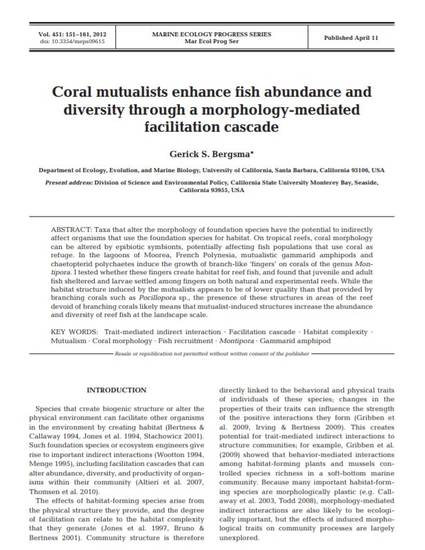
Article
Coral mutualists enhance fish abundance and diversity through a morphology-mediated facilitation cascade
Marine Ecology Progress Series
(2012)
Abstract
Taxa that alter the morphology of foundation species have the potential to indirectly affect organisms that use the foundation species for habitat. On tropical reefs, coral morphology can be altered by epibiotic symbionts, potentially affecting fish populations that use coral as refuge. In the lagoons of Moorea, French Polynesia, mutualistic gammarid amphipods and chaetopterid polychaetes induce the growth of branch-like ‘fingers’ on corals of the genus Montipora. I tested whether these fingers create habitat for reef fish, and found that juvenile and adult fish sheltered and larvae settled among fingers on both natural and experimental reefs. While the habitat structure induced by the mutualists appears to be of lower quality than that provided by branching corals such as Pocillopora sp., the presence of these structures in areas of the reef devoid of branching corals likely means that mutualist-induced structures increase the abundance and diversity of reef fish at the landscape scale.
Keywords
- Trait-mediated indirect interaction,
- Facilitation cascade,
- Habitat complexity,
- Mutualism,
- Coral morphology,
- Fish recruitment,
- Montipora,
- Gammarid amphipod
Disciplines
Publication Date
April 11, 2012
DOI
10.3354/MEPS09615
Citation Information
Gerick S. Bergsma. "Coral mutualists enhance fish abundance and diversity through a morphology-mediated facilitation cascade" Marine Ecology Progress Series Vol. 451 (2012) p. 151 - 161 Available at: http://works.bepress.com/gerick-bergsma/3/
